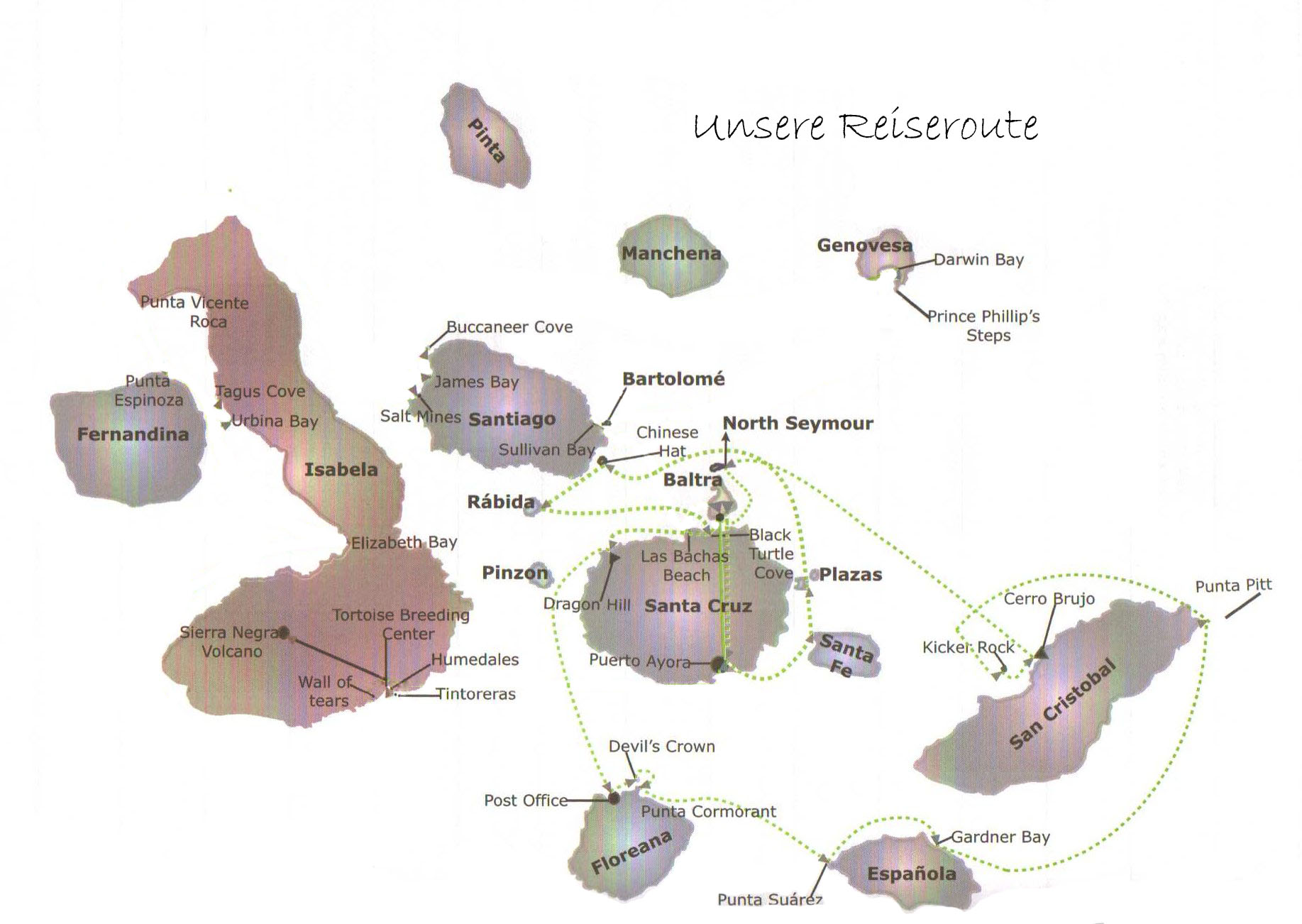
Deutsch
Flight with KLM via Amsterdam to Ecuador, our guide Fernando was waiting at the new airport outside of Quito for us. The journey to the city center followed by the usual mega-jams. Quito currently has a lot of construction work under-way, a new subway, the road to the airport, new homes and Industrial plants. Because of the traffic situation "pico y placa" was introduced, vehicles with certain number plates may, on an hourly basis, not drive within Quito once a week.
For this reason the next day our first tour didn't start before after 9:30 AM. After we had explored Quito and the south in 2009, the regions on the program were Sierra (North) this time and Mindo. We were very lucky with the weather and were able to see at least from the distance the snow-capped peaks of the volcanoes Cayambe and Cotopaxi, both of them close to or even more than 6000 m high. On the agenda this time were the famous Otavalo market with its colorful weavings, the Lago San Pedro and the nature reserve Cotacachi around the same volcano.
On day 3, we were greeted by guide Fernando who drove us into the region Mindo, only 1300 m of altitude. This nature reserve is surrounded by cloud forest and is known as a starting point for bird watching. We visited the Bella Vista Lodge and watched only there already about 20 different hummingbird species. In Mindo we visited a butterfly farm and in the afternoon the Museo de Tulipe, an archaeological museum on the life of the Yumbo Indians 800-1660 AD.
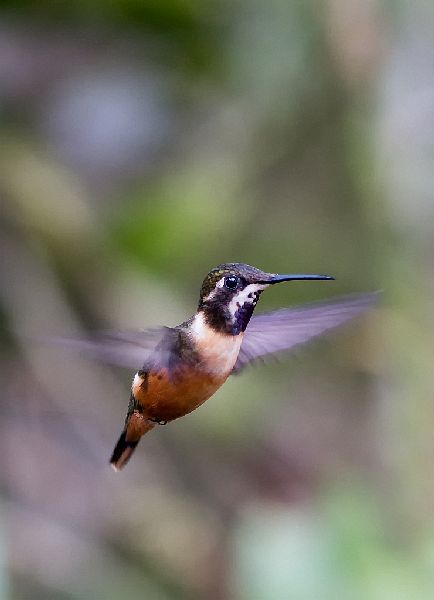 |
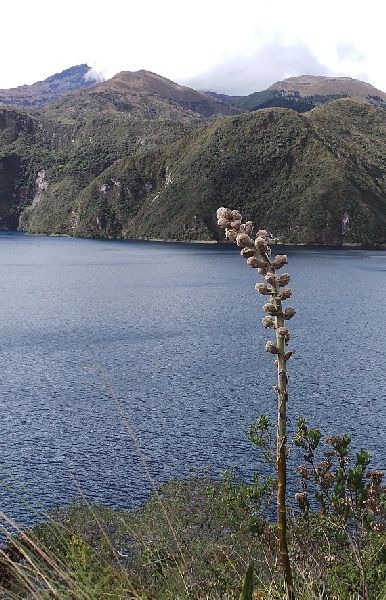 |
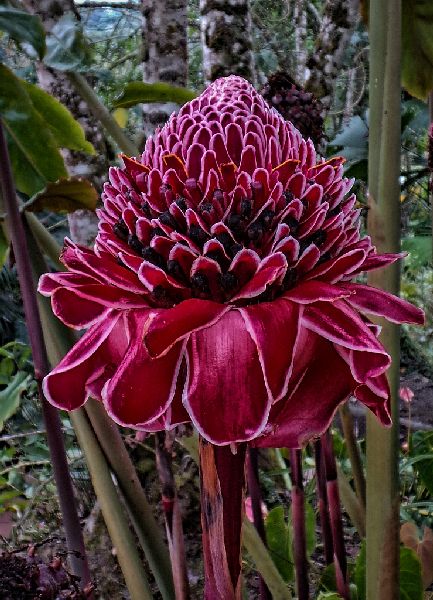 |
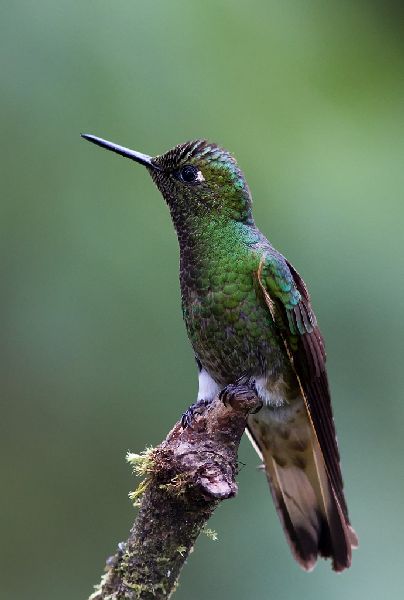 |
After attending an art opening, which took place at the Art Hotel Silberstein in the City, it was already time to say goodbye to Ecuador, meant an early flight to Baltra / Galapagos unfortunately an all too early pickup at the hotel at 4:30 o'clock.
Day 4 went by with a lot of waiting, initially at Quito airport, then at the stop in Guayaquil and finally at the entry to Galapagos.
At least with 2 hours delay our female guide Angelica brought us to our boat "MY Tip Top 3", which waited for us at the harbor of Puerto Ayora on Santa Cruz. For the first 3 days we were 10 guests on board (from Canada, New Zealand, the USA and ourselves from Germany), then a further 6 other people joined, a French family.
Day 5 Galapagos - Islas Santa Fe und South Plaza
At 7 o'clock in the morning we got to know the Garua, typical for this time of the year (dry season, however in the morning drizzle, reason is the coincidence of the cold waters of the Humboldt current and the tropical air, resulting in the fog at the hills). Ride on the boat, that is panga, (wet Landing) to the island of Santa Fe, where a larger colony of Galapagos Sea-Lions lives. On a hike then we met the first Land-Iguanas, blue-footed Boobies, Galapagos Mockingbirds, and one of the trusting Buzzards (Galapagos Hawk). Afterwards, snorkeling with the pups of the Sea-Lions in the cool water of a maximum of 19 degrees.
Afternoon crossing to Plaza Sur (South Plaza), this island is very scenic and beautiful to look at because of the colored vegetation. The Red Coral Bush in the dry season is a red Carpet, broken only by occasional Cactus-Trees.
Here one meets Sea-Lions everywhere, that make place at the jetty only reluctantly, also breeding seabirds, especially Swallow-tailed Gulls, Pelicans, Boobies and also here again, the Land Iguanas.
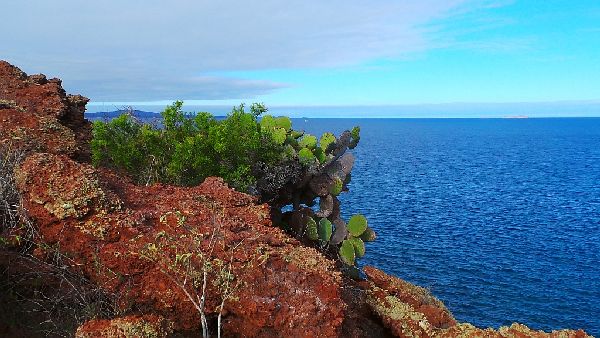 |
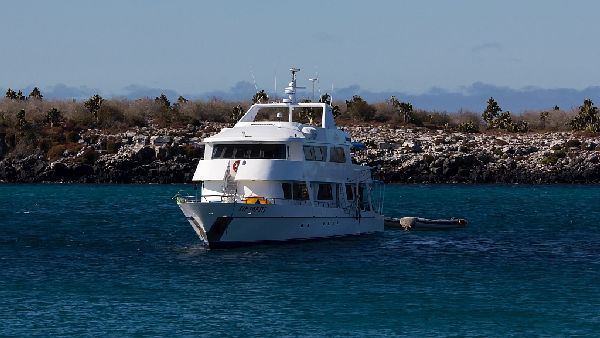 |
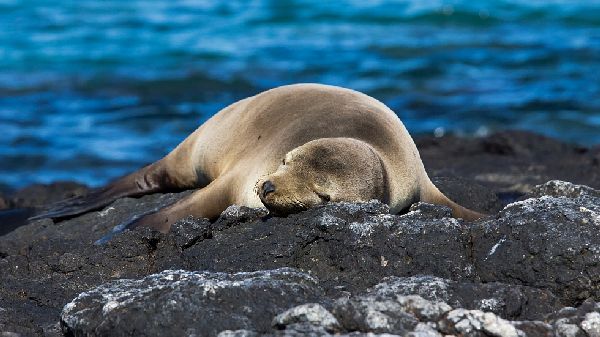 |
Day 6 Galapagos, Islas Sombrero Chino (Chinese Hat) & Rabida
In the morning there were many clouds and drizzle during our country-walk. The "Chinese Hat" is a tiny island southeast of Santiago, which owes its name to a volcanic crater in the shape of a hat. We have seen different lavastructures there, a lava tube, a lot of Red Crabs, Marine Iguanas, a Lava Heron. We were greeted here by several Sea Lions, including a cub, which probably was born just before our arrival.
Rabida Island is located south of Santiago, and is rich in various forms of lava. the "wet landing" is performed here on a dark red beach, whose color stems from iron-rich volcanic slag. The Sea Lions with their playful cubs expected us back here. The island is known for the breeding grounds of Brown Pelicans. On our walk on the shore, we also met Finches, Mockingbirds, Boobies, Frigate Birds and Sea- and Lava-lizards. In our opinion one of the best photo spots due to the dark red sand.
Day 7 Galapagos, Baltra & Dragon Hill
Morning 6 o'clock: Pangadrive to Turtle Cove Bay (mangroves), then ride to the island of Baltra because linnen-changes on board, and the ship was to be refueled. We pass the time at the mini beach on Baltra, together with the famous Sea Lions and some Finches.
Afternoon sail to Dragon Hill on Santa Cruz Island.
Dragon Hill takes its name from the resident Land Iguanas, quite numerous are represented. Also visible: Lava Herons, Great Blue-heron, Blue-footed Boobies, Galapagos Mockingbirds, Finches, Stilt-walkers, Smooth-billed Ani (immigrants from Ecuador), and 4 Flamingos in the salt water lagoon directly behind the beach, the latter have become quite rare in the Galapagos.
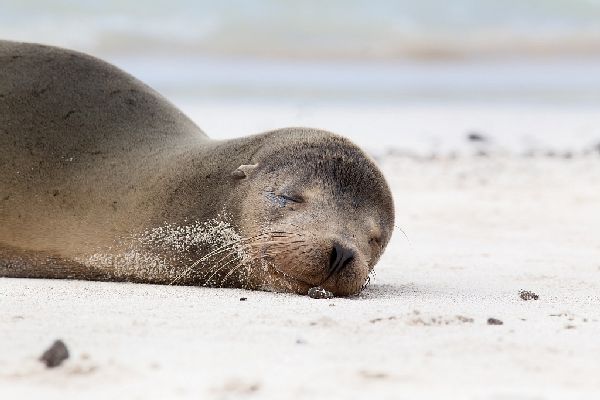 |
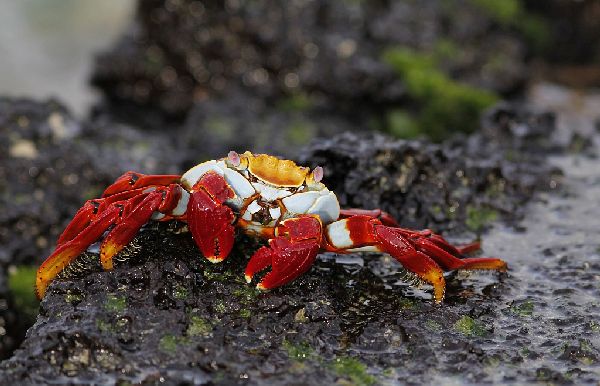 |
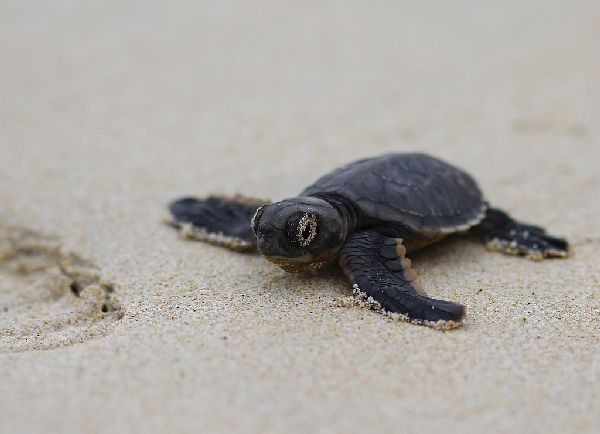 |
Day 8 Galapagos, Floreana
Early morning visit to the historic "Post Office", a wooden barrel in which tourists deposit their Postcards, at the same time take mail for their home country for referring it to the post-office there or even handdeliver it. Afterwards visit to a lava tube (very dark, you need a flashlight). On return to the ship sighting of a small group of Galapagos Penguins.
After that trip to, the island's interior (Highland), where we saw several Giant-tortoises in a protected area, and the former dwelling of the German family Wittmer (the story behind it can be read in the book "Floreana" by Margret Wittmer).
Afternoon snorkel tour at Corona del Diablo (Devil's Crown), after a hike at Punta Cormorant. We met again a small group of Flamingos, then on a beach we found a nest with young Sea-turtles, two were already straight on the road towards the sea. We saw their first outing, unfortunately one of them a short time later was the victim of a Frigate Bird. On the way back to the panga we found a family of Blue-footed Boobies with their young birds.
Day 9 Galapagos, Espanola
After a harrowing night-crossing with lots of wind and wave we finally arrived to our "desired" destination on the Galapagos, the island of Espanola. The most famous point there is in the west of the island and is called Punta Suarez. The island of Espanola belongs geologically to the oldest in the archipelago. Unique there is the nesting colony of the Galapagos Albatrosses (Diomedea irrorata), also Blue-footed and Nazcaboobies are on the island. We were also observers of an off-season bridal dance held by an Albatross-couple, as well as a couple of the famous departures from the cliff.
In the afternoon we took a walk along the beach at Bahia Gardner, passed Sea Lion colonies, Sea Turtles, Espanola Mockingbirds and a single Buzzard sitting on his stand hunting, not beeing annoyed in any way by us.
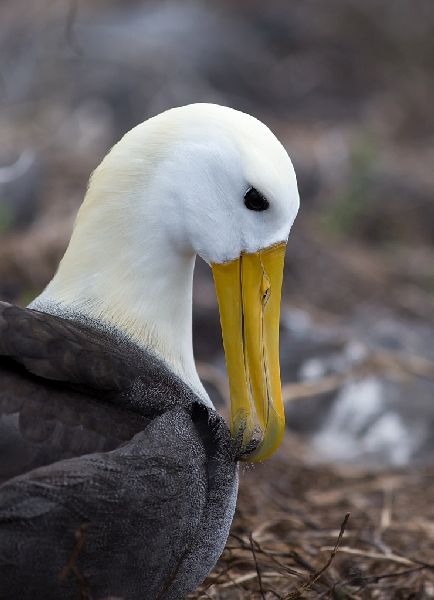 |
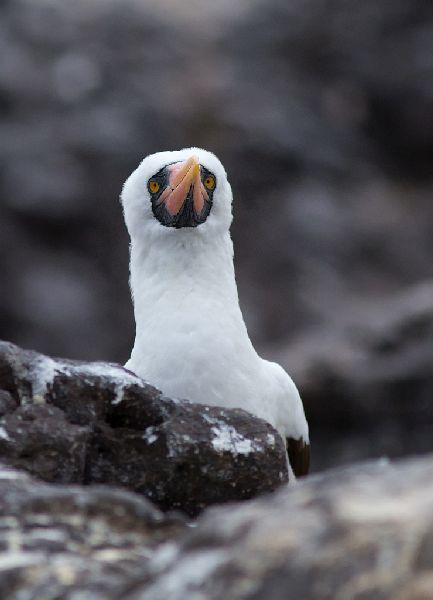 |
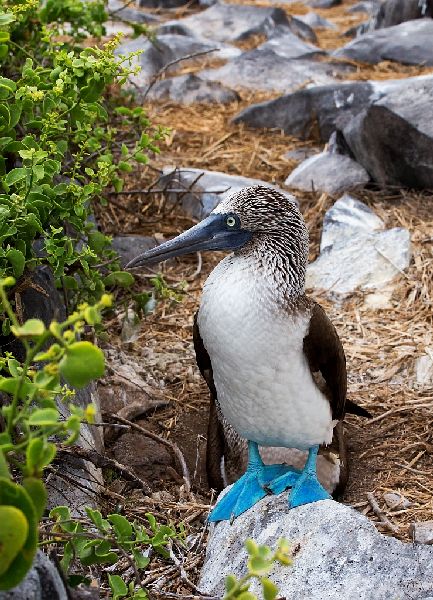 |
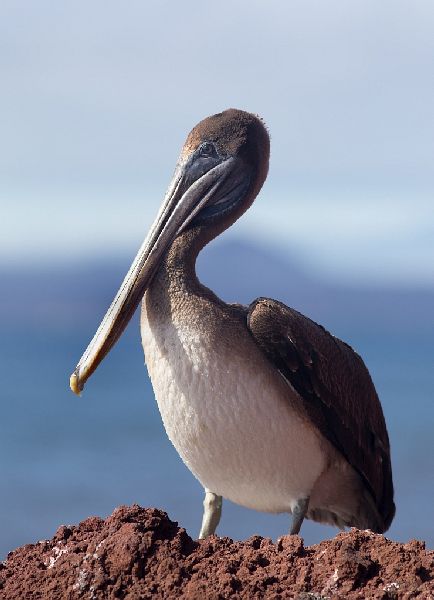 |
Day 10 Galapagos, San Cristobal
Punta Pitt located in the northeast of the island is very interesting for bird lovers, as all three booby-species occurring on Galapagos can be seen here: Blue-footed, Red-footed and Nazcaboobies. The Trail passes through the interior of a sleeping volcano to the cliffs, where again the nesting sites for boobies can be seen.
Further north there was a spectacular snorkeling site, the "Leon Dormido" (Kicker Rock). "We have rarely seen a place in the world with so many sharks, turtles and eagle rays accompanying us, hovering above our heads Pelicans also dipped into the water from time to time.
In the afternoon we took a panga to Cerro Brujo, with several caves that we could visit, then there was one last walk on the beach.
Day 11 Galapagos, Seymour Norte & Santa Cruz
The final tour took us at 6 o'clock to the Island just north of Baltra with the countless nests of Blue-footed Boobies and magnificent Frigate-Birds. Do the former usually nest in the salt bushes, it sometimes happens that the Boobies nest directly on the trail. Also, Marine Iguanas, Swallow-tailed Gulls and Sea Lions inhabit the island. Spectacular are the advertising methods of magnificent Frigate-Bird males when they inflate their bright red throat pouch.
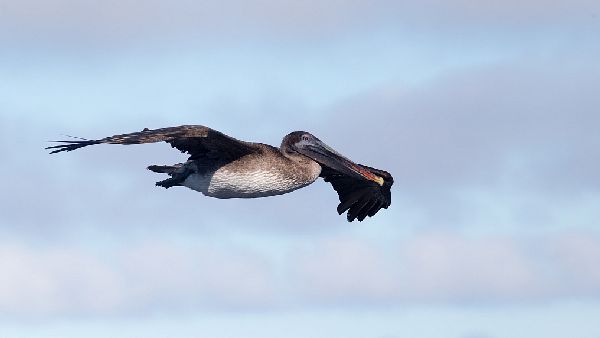 |
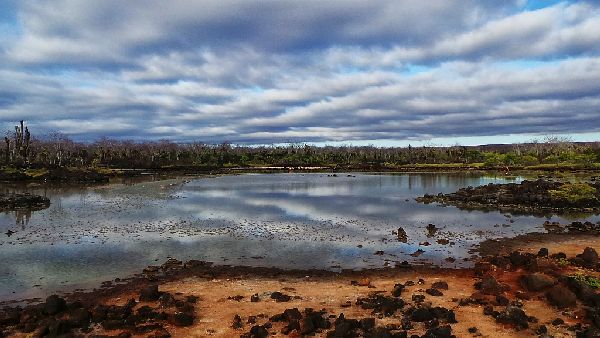 |
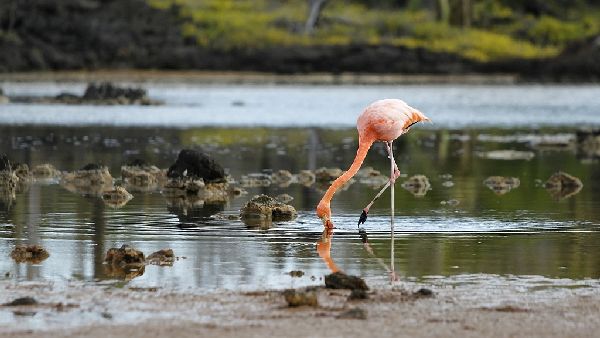 |
After a final breakfast on board disembarking began, the rest of our group flew back to Ecuador, we were taken to Puerto Ayora by taxi to the Hotel Silberstein, where we spent the second half of our vacation in the Galapagos.
The place is located at the Academy Bay on the south side of the island and serves many visitors as "Base-Camp" for their island excursions. In addition to hotels, restaurants, bars, there are many agencies where you can book last minute trips for example to the other islands of the archipelago. The fish market in Puerto Ayora regularly is visited by the brown pelicans.
Day 12 Galapagos, Puerto Ayora
In the morning we took our time at the Charles Darwin Research Station, where we have gotten a lot of information about the development history of the Galapagos Archipelago. Also the Breeding area for turtles who spend three to five years at the station can be visited, afterwards they are returned to their place of origin.
Day 13 Galapagos, Diving at Santa Fe (Cave & La Punta)
It's been a bit crazy to dive in August at the Galapagos. High waves and the constant rocking make the trip to the dive sites very difficult. However, under water one is compensated by the many schools of fish. There are still these fabulous "fish soups" of Salema, Snapper, Mackerel and Barracuda. In addition at Santa Fe, however at only 16 degrees water temperature, we saw first-ever a Catshark, several Stingrays, Eagle Rays, Cownose rays as well as Turtles. On ascending the Sea Lions came and performed somersaults for us.
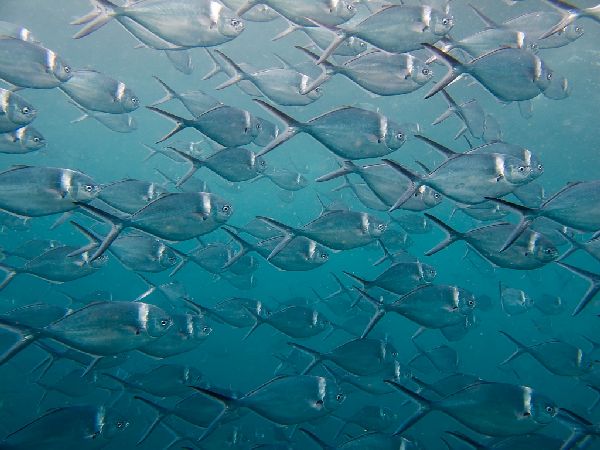 |
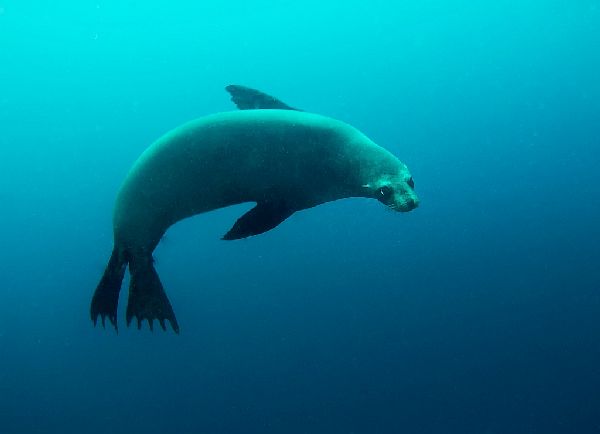 |
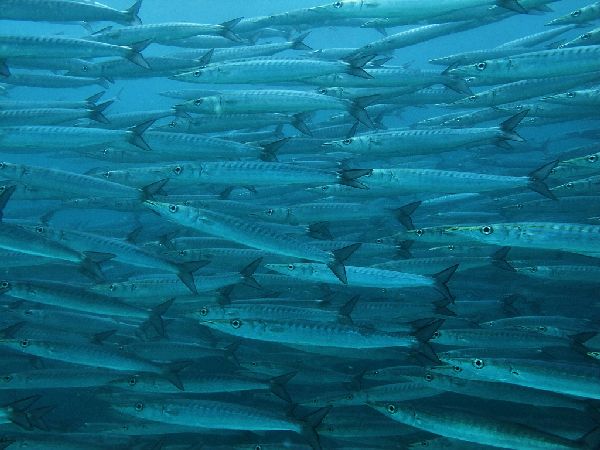 |
Day 14 Galapagos, Diving at Gordon Rocks
Unfortunately, the journey again was extremely unpleasant and site conditions were difficult because of strong currents and turbulence under water. The Hammerhead Sharks were there, but hardly visible because of poor visibility. It's still a great feeling to dive directly into a school of fish. During Antjes 700 Anniversary-dive a long time a turtle posed with their cleaning fish for us and then even a huge school of Barracudas passed by. On the second dive, the visibility was even worse, and the current even more extreme, so we had to stop the dive already after 39 minutes.
Day 15 Galapagos, Diving at Mosquera and Seymour Norte
This time the largest part of the travelling was by bus to the Canal de Itabaca, where we "entered" our dive boat. This saved us at least an hour wind and especially the waves. The journey to the channel to the two adjacent islands lasted only 15 minutes. Unfortunately, the water temperature because of thermoclines sometimes only at 15 degrees, similar to those of Santa Fe. The Sea Lions did not bother, next to us were chasing fish and performing their show for us. For a video click here. We found another Gurnard, Eagle- and Sting-Rays, Moray Eels and a large Whitetip Reef Shark. The second dive was almost more exciting than the first, the amount of fish in the Galapagos Archipelago is really very impressive. We found five large schools of Snappers, Mackerel, Surgeonfish and last but not least, a school of Barracudas, as we had never seen before somewhere.
Day 16 and 17 Galapagos, Puerto Ayora, Santa Cruz
We visited the incredibly beautiful Tortuga Bay and on our last day once again the Finch Bay and Las Grietas, where we stayed in 2009. Also the fish market was worth a daily visit. In the evening we took turns going into the restaurant "Il Giardino" or "Garrabata", preferably for fish dishes, Risotto or seafood.
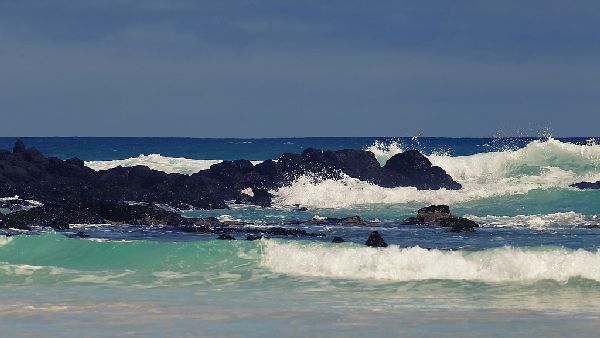 |
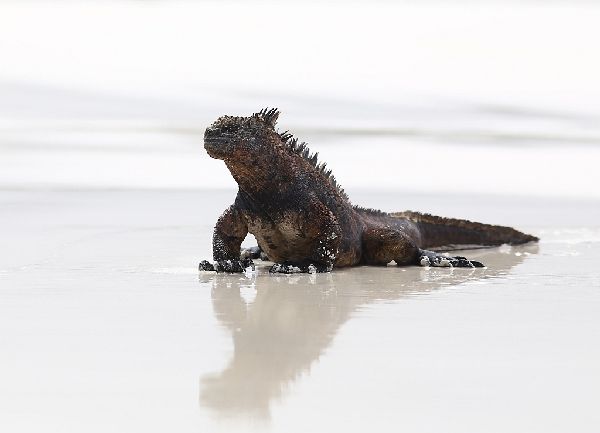 |
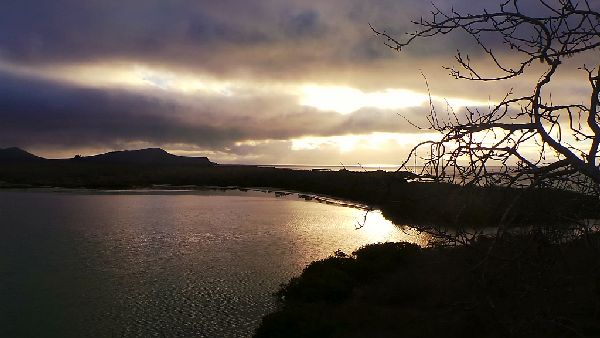 |
Day 18 Going home again
The day started early and ended late with the transfer to Baltra, flight to Guayaquil,
waiting for the onward flight and finally the flight back to Dusseldorf via Amsterdam. Unfortunately
our patience was sorely strained, as the airline Aerogal on the way from Galapagos to Ecuador
demolished our suitcase. Only after 2 hours, a person were found on the Guayaquil airport, English speaking and
somewhat competent. The remaining transfer time was spent waiting at check-in, in the emigration and
of course at the security checkpoint, it was an incredibly tough settlement at this airport.
![]()
Summary:
It has been beautiful as we had imagined it to be. 2009 was good, 2013 was even better, as we had planned much better. There were many highlights: Of course, the so longed Albatrosses at Espanola, the reunion with the Blue-footed Boobies, the small Sea-Turtles just hatched, the tame Hawk ( Galapagos Hawk ) at Santa Fe, the interaction with the Sea Lions on land and under water, the red sand on Rabida, the many Sharks at San Cristobal ( Kicker Rock ) and the incomparable schools of fish that we met at Gordon Rocks and North Seymour diving. Additionally, the information and stories about the flora and fauna of this archipelago, which we received from our guide Angelica and the friendly and helpful crew of the MY Tip Top 3, both of which we hereby absolutely recommend. Galapagos is its own little world and we are glad to have been their guest for some time.
